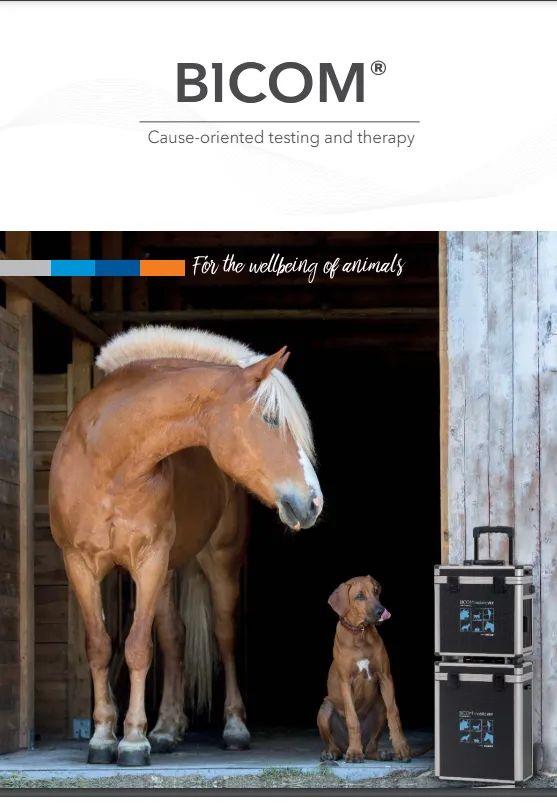BICOM® Bioresonance
Stress-free for pets and pet owners Suitable for all types of animals
There are many dogs , cats and horses suffering from health problems worldwide.
Be it problems with the musculoskeletal system, allergies and food intolerances or chronic diseases.
Sometimes, as an animal owner, you are at a loss when you can’t get any further with conventional therapy methods.
Like acupuncture or homeopathy, bioresonance belongs to the field of complementary medicine and is intended to be a useful supplement to conventional medicine.
It works with the body’s own wavelength of the four-legged friend, is used without medication and is painless to use.
Of course, not all health problems can be resolved with bioresonance. It is best to talk to a veterinarian or animal naturopath.
With our therapist finder you can find the nearest practice that can offer you BICOM® bioresonance.
Pain-free testing and therapy
Treatment with the BICOM® device is painless and stress-free. Especially sensitive animals feel very comfortable and it often happens that they completely relax and come to rest during the therapy.
Bioresonance has no harmful side effects and is used without medication.
Occasionally, initial aggravations, in what is known as the body’s initial reaction, can occur. However, these fade away after a short time.
What Pet Owners are saying..

Top Expert Insights on the Dangers of Bioresonance Therapy
The Real Science Behind the Dangers of Bioresonance Therapy
Bioresonance therapy has gained popularity over the past few years, especially as an alternative treatment for a variety of health conditions. Advertised as a safe and non-invasive procedure, bioresonance promises to detect and correct imbalances in the body through electromagnetic frequencies. However, despite its claims, the real science behind bioresonance therapy raises significant concerns.
In this blog, we will explore the dangers of bioresonance and highlight why you should be cautious when considering this treatment.
What Is Bioresonance Therapy?
Bioresonance therapy is based on the principle that each living cell in the body emits electromagnetic frequencies. According to proponents of this therapy, when the frequencies are disrupted or imbalanced, it leads to illness and disease. Bioresonance devices claim to detect these imbalances and then restore the body’s natural frequency patterns, purportedly helping to heal various health conditions.
While bioresonance therapy may sound intriguing, it’s important to understand that it is not supported by rigorous scientific research. There is little evidence to suggest that these devices can detect imbalances in the body, let alone treat them effectively. Instead, much of the reported success can be attributed to the placebo effect or the subjective nature of the symptoms being treated.
The Dangers of Bioresonance Therapy
Though marketed as a safe, drug-free alternative, bioresonance therapy carries several risks that should not be ignored. These risks can lead to adverse health effects or, at the very least, prevent individuals from seeking proper medical care.
1. Lack of Regulation and Oversight
One of the primary dangers associated with bioresonance therapy is the lack of regulatory oversight. Unlike conventional medical treatments, bioresonance is not subject to the same standards or guidelines. This lack of regulation opens the door for unqualified practitioners to offer treatments with little or no formal training or experience.
Unqualified Practitioners: Since bioresonance therapy is not regulated by medical boards, anyone can offer this treatment. Many practitioners may not have the necessary qualifications to diagnose or treat health conditions safely.
Unapproved Equipment: Many bioresonance devices are not approved or tested for safety. As a result, there’s no assurance that the equipment is safe for use, leading to potential health hazards, such as improper electromagnetic exposure.
With bioresonance devices being sold and used without strict standards, patients are at risk of receiving ineffective treatment, or worse, harmful exposure to unregulated devices.
2. Delayed Diagnosis and Treatment
One of the most significant dangers of bioresonance therapy is that it may cause a delay in receiving proper medical treatment. Since bioresonance is often presented as a holistic or natural alternative to conventional medicine, some individuals may opt for it instead of seeking medical advice or diagnosis.
Missed Health Conditions: When patients choose bioresonance therapy over a visit to a qualified healthcare professional, they risk missing critical diagnoses. Health conditions such as cancer, diabetes, and cardiovascular disease require medical attention, and the failure to address these serious conditions in a timely manner can be life-threatening.
Worsening Health Problems: Delaying medical treatment could lead to the worsening of symptoms or complications. For instance, if someone with an untreated bacterial infection relies solely on bioresonance therapy, their infection could spread, making it harder to treat later on.
While bioresonance therapy may provide temporary relief or even make people feel better, it can detract from real solutions, especially when there is a legitimate underlying health issue.
3. False Sense of Security
Bioresonance therapy can create a false sense of security among individuals who turn to it for healing. The promise of a non-invasive, holistic treatment can sometimes lead people to believe that their health concerns are being fully addressed.
Temporary Relief: While some people may feel temporary relief from symptoms like pain or fatigue after a bioresonance session, this relief is often short-lived. The therapy may not actually be addressing the root cause of the issue, leading to a return of symptoms.
Overlooking Real Solutions: Many people get caught up in the idea of “natural” or “energy-based” healing methods, and as a result, they may choose bioresonance therapy over scientifically proven treatments. Unfortunately, this can delay the correct course of action and prevent patients from receiving the best possible care.
If a health issue is not correctly diagnosed or treated, it will only persist or worsen, undermining the idea that bioresonance is a complete solution to health problems.
4. Potential Side Effects
Though bioresonance therapy is marketed as a gentle and non-invasive procedure, it does come with its own set of risks. Some individuals may experience side effects from the therapy itself, as well as from the electromagnetic fields used in the treatment.
Common Side Effects: The most common side effects reported by people undergoing bioresonance therapy include fatigue, dizziness, and mild discomfort. These symptoms often occur during or shortly after a session and can persist for a few hours or even days.
Long-Term Health Risks: Since bioresonance therapy involves the use of electromagnetic fields, there is concern about the long-term effects of prolonged exposure. Although the research on this is still limited, some believe that the use of these frequencies could lead to negative effects on the body, such as interference with cellular activity or damage to tissues over time.
Without adequate studies and understanding of the long-term consequences, the safety of bioresonance therapy remains uncertain, and any potential harm cannot be ignored.
The Scientific Proof Behind Bioresonance Therapy
Despite its widespread use, bioresonance therapy lacks scientific validation. Many practitioners claim that the treatment is based on the principles of quantum physics and energy medicine, but the actual evidence supporting these claims is scarce.
Limited Research: While there have been some studies on bioresonance, they often suffer from methodological flaws, small sample sizes, and a lack of rigorous controls. The evidence does not support the idea that bioresonance devices can detect or correct imbalances in the body in a meaningful way.
Placebo Effect: In many cases, the perceived benefits of bioresonance therapy may be a result of the placebo effect. This psychological phenomenon occurs when patients experience real changes in their symptoms because they believe the treatment is working, even though there is no active physiological process taking place.
In short, the current scientific evidence does not support bioresonance therapy as a reliable or effective treatment for health issues.
The Risks of Bioresonant Devices
A major concern with bioresonance therapy is the use of devices that are often unregulated and untested. These devices can carry risks, especially if they are not properly calibrated or if they deliver harmful electromagnetic fields.
Unregulated Devices: Most bioresonance devices are not approved by health authorities such as the FDA or other regulatory bodies. This means there’s no guarantee that they are safe or effective. Unapproved devices may pose safety risks, especially if they malfunction or produce harmful frequencies.
Electromagnetic Radiation Exposure: Some bioresonance devices rely on electromagnetic fields that can be harmful with prolonged exposure. Even though these devices are generally marketed as safe, the long-term effects of frequent exposure to these fields are still unknown, making it crucial to approach their use with caution.
Without proper regulation and oversight, bioresonance devices can be dangerous, both in terms of their effectiveness and their potential to cause harm.
Is Bioresonance Therapy Right for You?
While the idea of bioresonance therapy may seem appealing, it is important to consider the risks involved. There is no scientific proof that this therapy can effectively treat medical conditions, and relying on it instead of seeking proper medical care could have serious consequences.
Consult a Healthcare Professional: If you’re experiencing health issues, the best course of action is to consult with a qualified healthcare provider who can offer evidence-based treatments that have been proven to be safe and effective.
Exercise Caution: If you still choose to explore alternative therapies like bioresonance, make sure to do your research and proceed with caution. Understand the risks and limitations of the therapy and seek professional guidance to avoid putting your health in jeopardy.
Conclusion
Bioresonance therapy may seem like an appealing, non-invasive solution to various health issues, but it carries significant risks that should not be ignored. From unregulated practitioners to the potential for delayed diagnosis, the dangers of bioresonance should be carefully considered before making a decision. Always prioritize treatments that have been scientifically validated and are backed by proven results.
To find a vet near you please complete the form below
Quick Links








Facebook
Instagram
Mail